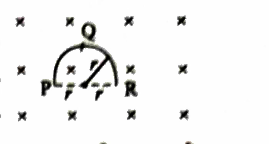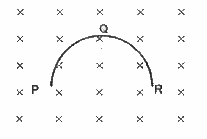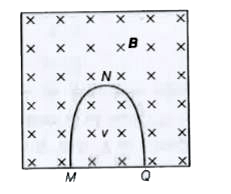A thin semi-circular conducting ring (PQR) of radius r is falling with its plane vertical in a horizontal magnetic field B, as shown in the figure. The potential difference developed across the ring when its speed v, is
 Solution in Tamil
Solution in Tamil
Zero
Bvπr22 and P is at higher potential
πrBVandR is at higher potential
2rBv and R is at higher potential
The correct Answer is:D
2rBv and R is at higher potential
Topper's Solved these Questions
- SAMPLE PAPER-16 (UNSOLVED)Book:FULL MARKSChapter:SAMPLE PAPER-16 (UNSOLVED)Exercise:PART-II
Explore 9 Videos
- SAMPLE PAPER-16 (UNSOLVED)Book:FULL MARKSChapter:SAMPLE PAPER-16 (UNSOLVED)Exercise:PART-III
Explore 9 Videos
- SAMPLE PAPER-1 (SOLVED)Book:FULL MARKSChapter:SAMPLE PAPER-1 (SOLVED)Exercise:Questions
Explore 28 Videos
- SAMPLE PAPER-2 (SOLVED)Book:FULL MARKSChapter:SAMPLE PAPER-2 (SOLVED)Exercise:Part -IV
Explore 10 Videos
Similar Questions
What are polar molecules ? Give examples.
View SolutionGive the relation between electric field and electric potential .
View SolutionWhat is meant by Fraunhofer lines?
View SolutionDerive an expression for electrostatic potential due to an electric dipole.
View SolutionA thin semi-circular conducting ring of radius R is falling with its plane verticle in horizontal magnetic induction (→B). At the position MNQ the speed of the ring is v, and the potential difference developed across the ring is

View SolutionA thin semicircular conducting ring of radius R is falling with its plane vertical in a horizontal magnetic induction B. At the position MNQ, the speed of the ring is V and the potential difference developed across the ring is

View SolutionA thin semicircuilar conducting ring (PQR) of radius r is falling with its plane vertical in a horizontal magnetic field B, as shown in Fig. The potential difference developed across the ring when its speed is upsilon , is
View SolutionA thin semicircular conducting ring of radius R is falling with its plane vertical in a horizontal magnetic induction B. At the position MNQ shown in the fig, the speed of the ring is V. The potential difference developed across the semicircular ring is
View Solutionr त्रिज्या की एक पतली अर्धवृत्ताकार चालक रिंग (वलय) PQR किसी क्षैतिज चुम्बकीय क्षेत्र B में गिर रही है । गिरते समय इसका समतल आरेख में दर्शाये गए अनुसार ऊर्ध्वाधर रहता है । जब गिरते हुए रिंग की चाल v है तो , इसके दो सिरों के बीच विकसित विभवान्तर है :

View Solutionचित्र में दिखाए अनुसार r त्रिज्या का एक पतला चालक अर्धवृत्तीय बलय (Ring) PQR एक क्षैतिज - चुंबकीय B में बलय के तल को - ऊर्ध्वाधर रखते हुए गिराया जाता है। जब इसकी चाल v हो तो बलय के सिरों के बीच उत्पन्न विभवांतर होगा

View Solutionr त्रिज्या की पतली अर्द्धवृत्ताकार रिंग PQR , किसी क्षैतिज चुम्बकीय क्षेत्र B में गिर रही है | गिरते समय इसका समतल , आरेख में दर्शाये गए अनुसार, ऊर्ध्वाधर रहता है | जब गिरती हुई रिंग की चाल v है तो इसके दो सिरों के बीच विकसित विभवांतर होगा -

View Solutionएक अर्द्धवृत्ताकार वलय जिसकी त्रिज्या R है अपने तल के लम्बवत क्षैतिज चुम्बकीय क्षेत्र B में गिर रही है। MNQ स्थिति पर वलय की चाल है तथा वलय में विभवान्तर है

View SolutionA thin circular -conducting ring having N turns of radius R is falling with its plane vertical in a horizontal magnetic field B . At the position MNQ the speed of ring is v the induced e.m.f developed across the ring is
View Solutionत्रिज्या R की एक पतली अर्द्धवृत्ताकार धात्विक वलय क्षैतिज चुम्बकीय प्रेरण B में इस प्रकार गिर रही है कि इसका तल ऊर्ध्वाधर रहता है। जब यह वलय MNQ की स्थिति में पहुँचती है तब इसका वेग । है। इस समय अर्द्धवृत्ताकार वलय में उत्पन्न विभवान्तर होगा

View SolutionA thin semicircular conducting ring of radius R is falling with its plane verticle in a horizontal magnetic inducting B . At the position MNQ , the speed of the ring is V and the potential difference developed across the ring is (1.) zero (2.) BcpiR^(2)//2 (3.) piRBV (4.) 2RBV
View Solution

